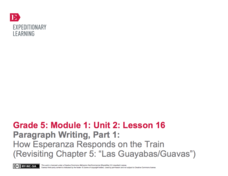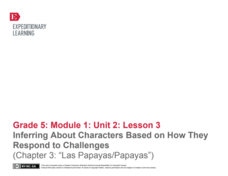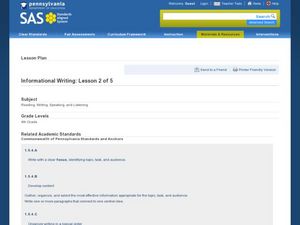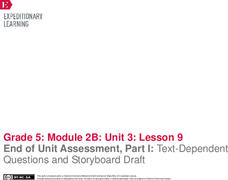Curated OER
Those Baffling Bibliographies!
Are you working on a research and citation unit? Have your young writers listen to a lecture on how to cite research sources correctly and how to distinguish new information that requires citing. They compile a list of works cited from...
EngageNY
Contrasting Perspectives: Should the Farmworkers in Esperanza Rising Go On Strike? (Chapter 12: "Los Esparragos/Asparagus")
Explore multiple perspectives through a jigsaw activity that will improve your pupils' understanding of the characters in Esperanza Rising as well as their understanding of strikes and human rights. Tapping into prior knowledge, and...
Curated OER
The Making of the Mahatma: Gandhi's Childhood
Students investigate the childhood of one of the greatest philosophers of our time, Gandhi. In this biography lesson, students analyze the upbringing and events that finally shaped Mahatma Gandhi's life. Students locate famous quotes...
EngageNY
Inferring About Characters Based on How They Respond to Challenges (Chapter 4: "Los Higos/Figs")
How do you know what a character's personality is like if an author doesn't tell you? With a focus on character development in Esperanza Rising, pupils complete a jigsaw activity to analyze the actions of Mama, Abuelita, and Miguel. Once...
EngageNY
Paragraph Writing, Part II
Come up with a list of requirements for this expository essay on Esperanza's character in Esperanza Rising as a class and use the list to guide class writing. Here, learners will complete the first paragraph, discuss their notes for the...
EngageNY
End-Of-Unit 2 Assessment: On-Demand Analytical Essay About How Esperanza Changes Over Time
Close the unit on Esperanza Rising with an in-class analytic essay on how Esperanza changes over the course of the novel. Writers can use any of their notes and work from the unit as well as their drafts of the first two paragraphs of...
EngageNY
Paragraph Writing, Part 1: How Esperanza Responds on the Train (Revisiting Chapter 5: "Las Guayabas/Guavas")
When your class members have completed the novel Esperanza Rising, they will be ready to write an expository essay on how Esperanza responds to events and what this says about her character. Set your pupils up for success by starting out...
EngageNY
Inferring About Characters Based on How They Respond to Challenges (Chapter 3: "Las Papayas/Papayas")
Start off your day with a quick reading comprehension quiz about chapter three of Esperanza Rising by Pam Muñoz Ryan. After they complete the quiz, pupils participate in a discussion and look closely at the text. A strong Common Core...
Curated OER
Write Some Dialogue
Students write dialogue. For this character development lesson students use direct or indirect speech to include a confrontation between two characters in their story. Students portray the emotions of the characters in addition to what...
EngageNY
Summarizing Complex Ideas: Comparing the Original UDHR and the "Plain Language" Version
The eighth lesson plan in this series continues the focus on vocabulary and increasing young readers' awareness of academic language. Pairs of learners participate in a short vocabulary review activity called Interactive Words in which...
EngageNY
Writing Narratives from First Person Point of View: Imagining Meg Lowman’s Rainforest Journal
I spy with my little eye! Learners observe page 23 in The Most Beautiful Roof in the World and practice what they would add to a field journal. They discuss how details from the text help add to their thoughts. To finish, readers use...
Curated OER
Direct and Reported Speech
Goldilocks and the Three Bears provide the text for a direct and reported speech worksheet. Pupils decide whether the model sentences are direct or reported speech and highlight the differences in the sentence pairs. They then...
Shoop English
Literature Terms Activity
Designed to be used with an independent reading book, this activity provides practice with identifying and explaining literary terms. While they read, individuals find instances of literary devices and elements in use in their books....
Pennsylvania Department of Education
Informational Writing: Lesson 2 of 5
Introduce expository writing to your elementary learners. Young authors write a three-paragraph informational paper using the steps of the writing process. They follow guided lessons to experience each of five steps. Included are tons of...
Curated OER
Clutter Busters
Commas, colons, and semicolons truly are the "clutter busters" of the written world. Students see many examples of how each are properly used, then must identify the sentence in each slide that uses these punctuation marks in the correct...
EngageNY
End of Unit Assessment, Part 1: Text-Dependent Questions and Storyboard Draft: “You Can Do a Graphic Novel” Excerpt
Eyes on the finish line. Serving as the first part of the end of unit assessment, learners answer questions based on a text about how to write a graphic novel. Using what they've learned, they then create a storyboard about the invention...
Curated OER
Hot Dog Writing
Use a hot dog as a metaphor for good reading, and make your class drool! Writers identify the parts of a paragraph, linking them to parts of a hot dog. Then, they translate this knowledge into a well-written paragraph. While a check-list...
Curated OER
Revising/Editing (3-5): Editing Marks. Part II and Literary Tools. Part II
Familiarize your class with commonly used editing marks. They apply the use of editing marks to a letter and examine different types of literary tools before making a note card resource for the tools. They add their own examples for each...
EngageNY
Revision and Illustration: Strengthening the Writing in my Rainforest Field Journal and Adding a Labeled Drawing
Let me draw you a picture. Scholars read a quote from Roger Tory Peterson and discuss his views on drawings. They then create their own drawings of an ant or butterfly to add to their science journals.
EngageNY
End of Unit Assessment, Part 1: On-Demand Essay “What Makes A Hurricane A Natural Disaster?”
It's time to refine writing and word choice. Learners work on Part 1 of their end of unit assessment by creating an essay titled What Makes a Hurricane a Natural Disaster? They use glossaries and graphic organizers from previous lessons...
Curated OER
Writing the Essay
Relate the structure of the essay to the structure of a building. The class compares an essay to a building, with the writer being the architect, the introduction being the foundation, and so on. They use the visual representation of a...
Scholastic
Biographical History
Elementary learners study and research an important historical figure. They research a historical figure and use a four square organizer to take notes. They develop a timeline and poem that reflects the life of the historical figure....
Curated OER
Direct and Indirect Speech
The basics of direct speech and indirect speech are outlined in this informative language arts presentation. Pupils see that these are the two ways to report what someone is saying. In direct speech, the speaker's exact words are used....
Curated OER
Onomatopoeia Poems
Students write onomatopoeia poems. In this creative writing lesson plan, students listen to a picture book that introduces the concept of onomatopoeia. Students create their own list of words and write a short poem using onomatopoeia.
Other popular searches
- Quiz on Using Quotations
- Using Quotations Marks
- Using Quotations Correctly
- Dialogue Using Quotations
- Using Quotations in Writing
- Using Quotations in Research
- Punctuating Using Quotations
- Using Quotations in Dialog
- Dialog Using Quotations

























